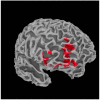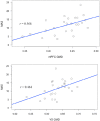Metacognition in Early Phase Psychosis: Toward Understanding Neural Substrates
- PMID: 26132568
- PMCID: PMC4519863
- DOI: 10.3390/ijms160714640
Metacognition in Early Phase Psychosis: Toward Understanding Neural Substrates
Abstract
Individuals in the early phases of psychotic illness have disturbed metacognitive capacity, which has been linked to a number of poor outcomes. Little is known, however, about the neural systems associated with metacognition in this population. The purpose of this study was to elucidate the neuroanatomical correlates of metacognition. We anticipated that higher levels of metacognition may be dependent upon gray matter density (GMD) of regions within the prefrontal cortex. Examining whole-brain structure in 25 individuals with early phase psychosis, we found positive correlations between increased medial prefrontal cortex and ventral striatum GMD and higher metacognition. These findings represent an important step in understanding the path through which the biological correlates of psychotic illness may culminate into poor metacognition and, ultimately, disrupted functioning. Such a path will serve to validate and promote metacognition as a viable treatment target in early phase psychosis.
Keywords: brain; early psychosis; magnetic resonance imaging; metacognition; schizophrenia.
Figures



Similar articles
-
Brain Structural Correlates of Metacognition in First-Episode Psychosis.Schizophr Bull. 2020 Apr 10;46(3):552-561. doi: 10.1093/schbul/sbz116. Schizophr Bull. 2020. PMID: 31776577 Free PMC article.
-
Association of medial prefrontal resting state functional connectivity and metacognitive capacity in early phase psychosis.Psychiatry Res Neuroimaging. 2017 Apr 30;262:8-14. doi: 10.1016/j.pscychresns.2016.12.014. Epub 2017 Feb 8. Psychiatry Res Neuroimaging. 2017. PMID: 28208070
-
Impairment of perceptual metacognitive accuracy and reduced prefrontal grey matter volume in first-episode psychosis.Cogn Neuropsychiatry. 2018 May;23(3):165-179. doi: 10.1080/13546805.2018.1444597. Epub 2018 Feb 27. Cogn Neuropsychiatry. 2018. PMID: 29485348
-
The neural underpinnings of associative learning in health and psychosis: how can performance be preserved when brain responses are abnormal?Schizophr Bull. 2010 May;36(3):465-71. doi: 10.1093/schbul/sbq005. Epub 2010 Feb 12. Schizophr Bull. 2010. PMID: 20154201 Free PMC article. Review.
-
The role of the hippocampo-prefrontal cortex system in phencyclidine-induced psychosis: a model for schizophrenia.J Physiol Paris. 2013 Dec;107(6):434-40. doi: 10.1016/j.jphysparis.2013.06.002. Epub 2013 Jun 17. J Physiol Paris. 2013. PMID: 23792022 Review.
Cited by
-
Metacognitive function and fragmentation in schizophrenia: Relationship to cognition, self-experience and developing treatments.Schizophr Res Cogn. 2019 Apr 24;19:100142. doi: 10.1016/j.scog.2019.100142. eCollection 2020 Mar. Schizophr Res Cogn. 2019. PMID: 31828019 Free PMC article. Review.
-
Prefrontal gray matter volume predicts metacognitive accuracy following traumatic brain injury.Neuropsychology. 2018 May;32(4):484-494. doi: 10.1037/neu0000446. Neuropsychology. 2018. PMID: 29809035 Free PMC article.
-
Metacognitive Deficiency in a Perceptual but Not a Memory Task in Methadone Maintenance Patients.Sci Rep. 2017 Aug 1;7(1):7052. doi: 10.1038/s41598-017-06707-w. Sci Rep. 2017. PMID: 28765624 Free PMC article.
-
Brain Structural Correlates of Metacognition in First-Episode Psychosis.Schizophr Bull. 2020 Apr 10;46(3):552-561. doi: 10.1093/schbul/sbz116. Schizophr Bull. 2020. PMID: 31776577 Free PMC article.
-
Metacognition as a Mediating Variable Between Neurocognition and Functional Outcome in First Episode Psychosis.Schizophr Bull. 2017 Jul 1;43(4):824-832. doi: 10.1093/schbul/sbw128. Schizophr Bull. 2017. PMID: 27590844 Free PMC article.
References
-
- World Health Organization/Mental Disorders. [(accessed on 14 April 2015)]. Available online: http://www.who.int/mediacentre/factsheets/fs396/en/
-
- Lysaker P.H., Vohs J.L., Ballard R., Fogley R., Salvatore G., Popolo R., Dimaggio G. Metacognition, self reflection and recovery in schizophrenia: Review of the literature. Future Neurol. 2013;8:103–115. doi: 10.2217/fnl.12.78. - DOI
Publication types
MeSH terms
Grants and funding
LinkOut - more resources
Full Text Sources
Other Literature Sources
Medical

